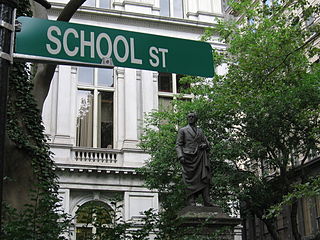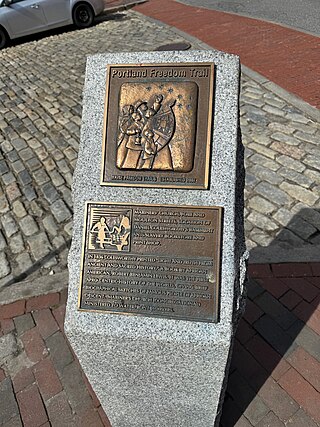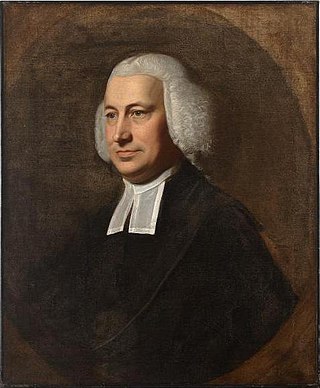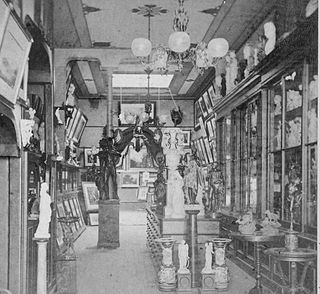This is a partial list of booksellers in Boston, Massachusetts .
This is a partial list of booksellers in Boston, Massachusetts .














Harvard Square is a triangular plaza at the intersection of Massachusetts Avenue, Brattle Street and John F. Kennedy Street near the center of Cambridge, Massachusetts, United States. The term "Harvard Square" is also used to delineate the business district and Harvard University surrounding that intersection, which is the historic center of Cambridge. Adjacent to Harvard Yard, the historic heart of Harvard University, the Square functions as a commercial center for Harvard students, as well as residents of western Cambridge, the western and northern neighborhoods and the inner suburbs of Boston. The Square is served by Harvard station, a major MBTA Red Line subway and a bus transportation hub.

School Street is a short but significant street in the center of Boston, Massachusetts. It is so named for being the site of the first public school in the United States. The school operated at various addresses on the street from 1704 to 1844.

The Old Corner Bookstore is a historic commercial building located at 283 Washington Street at the corner of School Street in the historic core of Boston, Massachusetts. It was built in 1718 as a residence and apothecary shop, and first became a bookstore in 1828. The building is a designated site on Boston's Freedom Trail, Literary Trail, and Women's Heritage Trail.
The Boston Board of Selectmen was the governing board for the town of Boston from the 17th century until 1822. Selectmen were elected to six-month terms early in the history of the board, but later were elected to one-year terms.

Daniel Clement Colesworthy was an American printer, bookseller, and poet.

The Brattle Street Church (1698–1876) was a Congregational and Unitarian church on Brattle Street in Boston, Massachusetts.

Samuel Cooper was a Congregational minister in Boston, Massachusetts, affiliated with the Brattle Street Church. He was born in Boston to William Cooper and Judith Sewall, attended the Boston Latin School, and was graduated from Harvard College in 1743. He was ordained as a minister on May 21, 1746, and served as pastor of the Brattle Street Church, 1747-1783. Members of his parish at the Brattle St. Church included some of the most influential people of the American Revolution: John Hancock, Samuel Adams, Joseph Warren, John Adams, and others. He corresponded with Benjamin Franklin, Charles Hector d'Estaing, Gideon Hawley, Charles Gravier de Vergennes; and was associated with Phillis Wheatley. In 1780, he co-founded the American Academy of Arts and Sciences. He served as "chaplain to the General Court" 1758-1770 and 1777-1783. Around 1783 Harvard College offered Cooper the position of college president, but Cooper declined. In September 1746 he married Judith Bulfinch; they had two daughters. A portrait of Cooper by John Singleton Copley now resides in the collection of the Massachusetts Historical Society.
Samuel Hale Parker (1781–1864) was a publisher and bookseller in 19th-century Boston, Massachusetts, United States. He published musical scores as well as novels, sermons, and other titles. He operated the Boston Circulating Library, and was among the founders of the Handel and Haydn Society.
John Mein was a bookseller and publisher in the time before the American Revolution. Mein started Boston's first circulating library, and with his business partner, John Fleeming, Mein published the Loyalist newspaper, the Boston Chronicle, the first semi-weekly in New England.

Dock Square in downtown Boston, Massachusetts, is a public square adjacent to Faneuil Hall, bounded by Congress Street, North Street, and the steps of the 60 State Street office tower. Its name derives from its original (17th-century) location at the waterfront. From the 1630s through the early 19th century, it served boats in the Boston Harbor as "the common landing place, at Bendell's Cove," later called Town Dock. "Around the dock was transacted the chief mercantile business of the town." After the waterfront was filled in during the early 19th century, Dock Square continued as a center of commerce for some years. The addition in the 1960s of Government Center changed the scale and character of the square from a hub of city life, to a place one merely passes through. As of the 1950s the square has become largely a tourist spot, with the Freedom Trail running through it. John Winthrop, coming from Salem where he landed as a Puritan from England, ended up "setting up a dock at the head of the cove, and here began the town of Boston, which soon was recognized as the political and economic center of the [Massachusetts Bay] colony.

Annin & Smith was an engraving firm in Boston, Massachusetts, in the 19th century, established by William B. Annin and George Girdler Smith. The firm kept offices on Court Street and Cornhill.
William Hilliard (1778–1836) was a publisher and bookseller in Boston and Cambridge, Massachusetts in the early 19th-century. He worked with several business partners through the years, including Jacob Abbot Cummings, James Brown, and Charles C. Little. President Thomas Jefferson selected his firm to supply approximately 7,000 volumes on numerous topics in 1825-1826, to create the University of Virginia Library.

Cornhill was a street in Boston, Massachusetts, in the 18th, 19th and 20th centuries, located on the site of the current City Hall Plaza in Government Center. It was named in 1829; previously it was known as Market Street (1807–1828). In its time, it comprised a busy part of the city near Brattle Street, Court Street and Scollay Square. In the 19th century, it was the home of many bookstores and publishing companies. As of 1969, Cornhill exists as 144 feet along the edge of City Hall Plaza.

Benjamin Guild (1749-1792) was a bookseller in Boston, Massachusetts, in the late 18th century. He ran the "Boston Book Store" and a circulating subscription library in the 1780s and 1790s at no.59 Cornhill, "first door south of the Old-Brick Meeting-House."

De Vries, Ibarra & Co. were "importers of paintings, engravings, bronzes, and works of art in general," "publishers of busts and statuary," and "importers and publishers of books in foreign languages." Based in Boston, Massachusetts, in the 1860s the firm kept a shop in the Albion Hotel building on Beacon Street, and later on Tremont Street. Proprietors included Guy Horvath De Vries and Mrs. De Vries. Staff included Carl Schoenhof, who bought the firm in 1870.

Sampson R. Urbino (1818-1896), also known as S.R. Urbino, was a book dealer, publisher, and library owner in Boston, Massachusetts, in the 19th century. He focused on books in languages other than English.

Brattle Street in Cambridge, Massachusetts, called the "King's Highway" or "Tory Row" before the American Revolutionary War, is the site of many buildings of historical interest, including the modernist glass-and-concrete building that housed the Design Research store, and a Georgian mansion where George Washington and Henry Wadsworth Longfellow both lived, as well as John Vassall and his seven slaves including Darby Vassall. Samuel Atkins Eliot, writing in 1913 about the seven Colonial mansions of Brattle Street's "Tory Row," called the area "not only one of the most beautiful but also one of the most historic streets in America." "As a fashionable address it is doubtful if any other residential street in this country has enjoyed such long and uninterrupted prestige."

Bela Marsh (1797-1869) was a publisher and bookseller in Boston, Massachusetts, in the 19th century. Authors under his imprint included Spiritualists and abolitionists such as John Stowell Adams, Adin Ballou, Warren Chase, Lysander Spooner, and Henry Clarke Wright. Marsh kept offices on Washington Street (ca.1820-1832), Cornhill (ca.1847-1852), Franklin Street (ca.1854-1856), and Bromfield Street (ca.1858-1868).